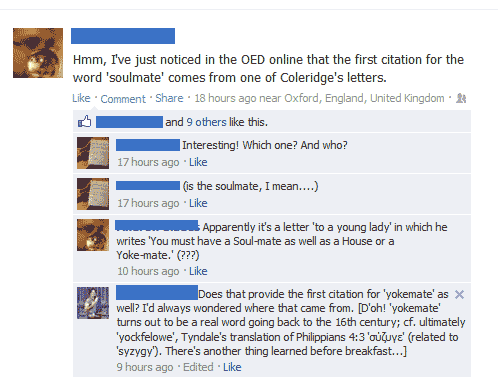Today’s Facebook brings a thread that does most of the legwork for a regular P&C-type post:
 In OED2, soul-mate was listed under soul, n., along with other compounds, such as soul carrier, -curer, -thief, and -twister. The new OED3 Online gives it its own headword, soulmate, n. and updates the Coleridge quotation to what you see above (whereas OED2 had the slightly different “You must have a Soulmate as well as a House or Yoke-mate.”).
In OED2, soul-mate was listed under soul, n., along with other compounds, such as soul carrier, -curer, -thief, and -twister. The new OED3 Online gives it its own headword, soulmate, n. and updates the Coleridge quotation to what you see above (whereas OED2 had the slightly different “You must have a Soulmate as well as a House or Yoke-mate.”).
Coleridge’s neology is pretty good, but the analogy is a bit fuzzy. A house mate shares your house; And two things that are yoked are indeed paired – a yokemate is just the other term in a pairing, even if the idea of the yoke also carries a connotation of a shared burden (and in fact yokemate gets reused in English in exactly this kind of figure: “1581. Neyther may they bee ioyned as yokemates, to drawe in the vineyarde of the Church”; though the idea is originally just “pairedness”).
But in soulmate, a soul isn’t the coupling agent, nor does a soulmate help you bear the weight of your soul, nor do you and your soulmate share a soul. Rather your soul finds an ideal companion in the soul of the soulmate. The two souls are companions to each other on the ethereal plane, just as the bodies are companions on the earthy plane, two terms sharing the burden of life, and the space of a house.
As the FB commenter says, this all goes back to the Greek for pair, couple, coupling. Syzygy in English means a conjunction of heavenly bodies, or a pair of opposites, or the joining of different kinds of feet in a poetic meter. It is from the same Greek root as zeugma, meaning a yoke, or pairing, or conjunction, and also a copulation.
But copulation-mate (= mating-mate?) is somewhat less romantic than “Yoke mate”, which is lovely. In the KJV, Phil 4:3 goes like this: “And I intreat thee also, true yokefellow …”. Today’s NIV has “my true companion,” which is not quite as lovely. Wycliffe has “german fellow,” which might make you scratch your head a bit (until you find the Vulgate is germane conpar). The New Living goes for “true teammate”, which might have been a good idea in theory (a “team of oxen” obviously on their mind) but turns out just omg awful. The God’s Word translation treats the epithet as a personal name: “Yes, I also ask you, Syzugus, my true partner.” In other versions it comes out as “sincere companion”, “loyal friend”, “faithful friend”, “true helper in my work”. No one has yet come up with soulmate, here.
Of course, soulmates, housemates, and yokemates all describe (among other things) husbands and wives–mates, that is, or helpmeets. Helpmate in fact probably comes from helpmeet. And if you think that helpmeet makes a lot less sense than helpmate, that’s probably because the word was born as the result of a mistake, again based in scripture. Genesis 2:18 describes the creation of the first mate like this, in the KJV:
And the Lord God said, It is not good that the man should be alone; I will make him an help meet for him.
Here meet means fitting, appropriate, and help means a helper. A fitting helper. But in the late 17th, we catch Dryden compounding the noun and adjective into a new noun:
1673 Dryden Marr. à la M. iv. i, If ever woman was a help-meet for man, my Spouse is so.
Helpmate appears about fifty years later, perhaps as a reanalysis of helpmeet, OED2 saying that applies “chiefly to a wife or husband”, as in the second quotation:
1722 De Foe Relig. Courtsh. ii. i. (1840) 187 A woman is to be a helpmate, and a man is to be the same.
By the time Coleridge wrote his “letter to a young lady,” all the -mates he recommended to her were functions desirable in a husband. The noun mate, which starts out meaning any kind of companion or fellow, starts to describe a spouse in the 1590s, when it pops up in Shakespeare and other sources. Similarly the verb mate, initially meaning “to rival”, “contend with”, to “match” (in that sense) or “to equal,” is first used in the sense of “to marry” by Marlowe, and Shakespeare (in Timon: “If she be mated with an equall Husband?”). [The use of mate, v. to mean “to copulate”, applied to animals, is first attributed to D. H. Lawrence in 1922 in OED2, though OED3 has removed this citation and combined the sense with another.]
So you know, the other word mate, meaning checkmate (verb, noun, and interjection) is a separate sense which, amazingly, is attested earlier than the more common one, in Arthur and Merlin and Sir Tristem (both early 14th C):
Vi heþen kinges driuen hardi..For to ȝeuen hem her mat.
‘Child, what wiltow lay?’ ‘Oȝain an hauke .. Tventi schillinges .. Wheþer so mates oþer fair, Bere hem boþe oway.’
Do you have a soulmate? XKCD runs the numbers:

[…] if not well in that category, which is why it was somewhat surprising and refreshing to learn that the OED lists Coleridge as the first user of the word. It was a reminder that common words can have uncommon origins–and that the coiner loses control […]